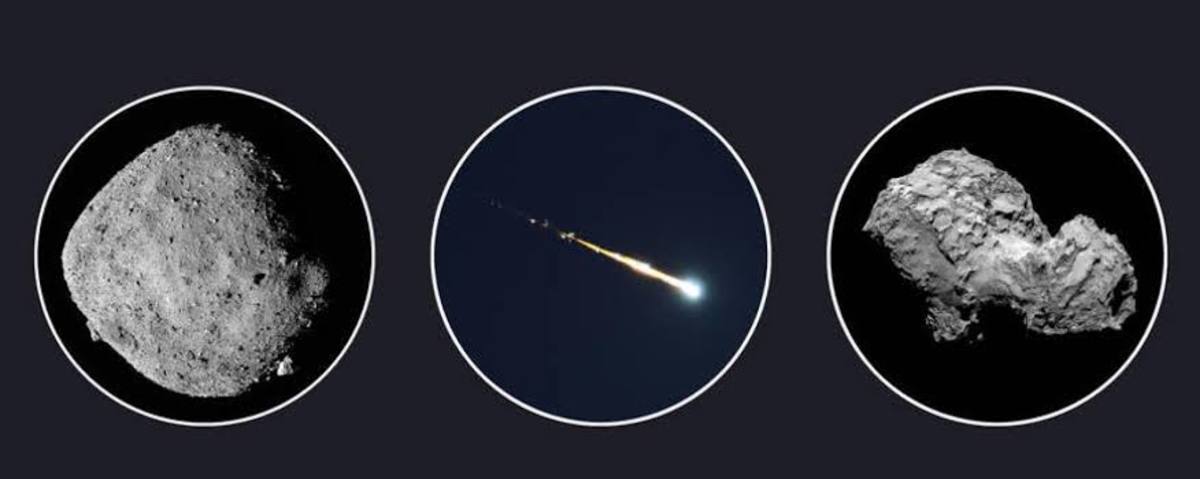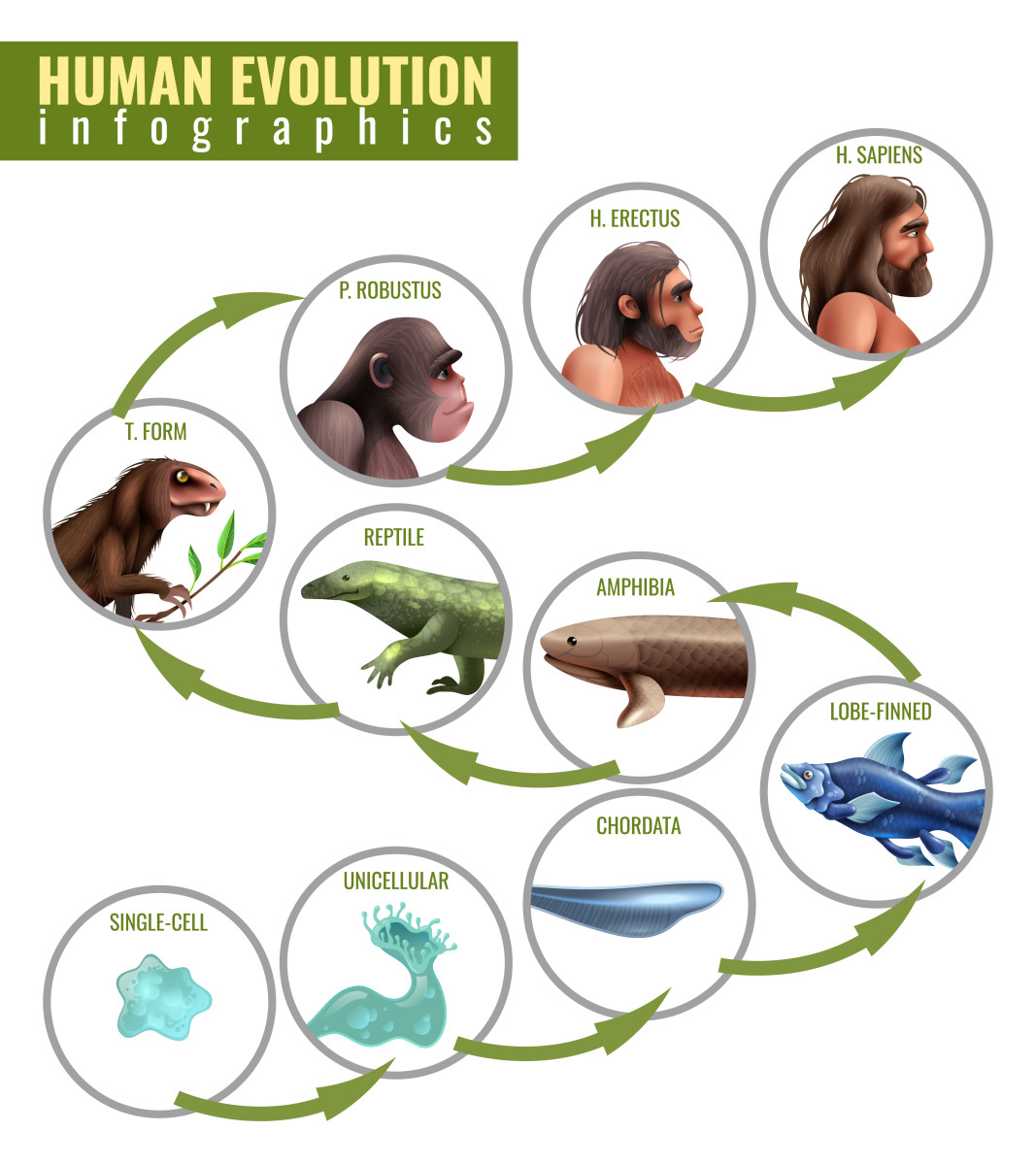Asteroids and Other Mass Killers
Time to time since Life appeared on Earth around 3,500_million_B.C. calamities from various natural causes including asteroid impacts decimated the planet's resident species. Disasters called "mass extinction" had happened when large numbers of whole species, a large part of Earth's living, was wiped out permanently from the planet (reference# wc1 at the end under 'Web references').
The very recent era of Man may not have produced yet similar forces of nature that were as destructive to life in general, although lesser agents could have time and again decimated mankind and reversed the latter's progress in the building of civilizations.
As early as 0.1_million_B.C. (or 100,000 years ago, reference# wf2), human activities and tools already had effects on the environment discernable to current studies. Men in that long span of time (discounting mass killers) may have sufficient chance to develop many times over sophisticated societies and civilizations.
The human stock itself had even much more ancient roots, diverging from the nearest relative ape in the hominoid family around 7_million_B.C. Analysis by a so called "DNA clock" (a technique in molecular biology - reference# pd1 at the end under 'Printed references') for family members in question was used to pinpoint the divergence.
Credible reference suggest (reference #s pe2, pe3) that humanity had prior civilization capable of wide enough influence on periods earlier than the 4,000_B.C. commonly believed as beginning of current civilization.
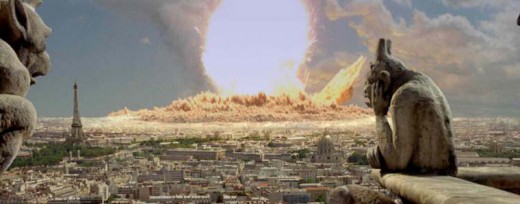
It is coming...!!!
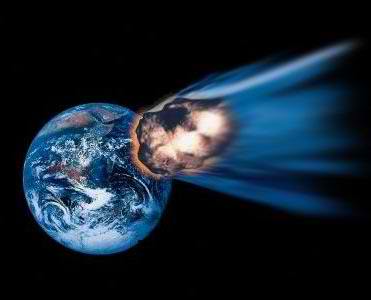
Earth had been battered since formation around 4,540_million_B.C. by countless impacts from celestial bodies and other upheavals. 176 impact craters so far anyway, as of 2,010_A.D. had been counted (reference# wa1).
Craters more than 1 kilometer across are 156 in number, or 91% of the total documented (significantly smaller craters may not last long).
The largest impact crater is 300 kilometers across ( formed around 2,023_million_B.C., plus or minus 4_million years), while while the earliest recorded impact 1s a 16 kilometer crater that formed around 2,400_million_B.C. in Russia.
The impact of celestial masses need not occur one at a time, but have a fair chance to be at least double cratered blows, dealt by multiple bodies that come in at the same time.
Radioactive dating on 30 large impact craters more than ten miles across spaced 9 to 30 miles apart showed that at least 6 were simultaneously created with another (reference pa1). Asteroids may orbit the sun in pairs bound gravitationally before smashing Earth together, as deduced by planetary scientist Jay Melosh (University of Arizona).
Celestial killer masses may not necessarily leave impact craters. Close encounters that are close enough of sufficiently sized masses may also kill massively without permanent mark on planet Earth.
The famous controversial explosion of 1908_A.D._(June30) on the skies of Siberia that had the hallmarks of a nuclear blast could have been that kind of close encounter (luckily as far as anyone knows only some few wild life got it).
(Varied opinions backed with good evidence had been given regarding the explosion - reference #s pa2, wg1. Among the more remarkable, one speculates of a nuclear powered extraterrestrial spaceship that exploded before it could land. Another says the explosion was caused by something that came from within Earth, not from outer space.)
The energy yield of the explosion as estimated by experts was on the order of 1,500 times as great as that of the atomic bomb dropped 37 years later in 1945_A.D._(August6) at Hiroshima, Japan.
Mass extinctions in past ages
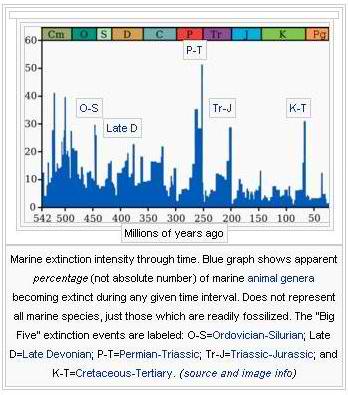
Mass Extinction books
Phenomena natural to Earth or from space were the usual causes of mass extinctions, with events classed as to swiftness by the two types which sometimes are encountered and/or debated for many scientific concepts - the gradualistic and the catastrophic events or happenings (reference# pb2). The earthly causes include phenomena like climate change, abnormal volcanism, among others.
Most early mass extinctions were gradual events with Earthly causes, while later events generally were catastrophes (in reference# wc2). Earth's thinner crust and greater internal in older ages could have started many of the causes for early events (reference# pa3).
A memorable mass extinction for many is what wiped dinosaurs around 65_million_B.C. wherein about 90% of Earth's life forms became extinct (in reference# pb1). Catastrophic asteroid impacts primarily caused that event, although a period of gradualistic changes in environment and climate may also have softened the dinosaurs.
The event was not the only disaster nor the worst that ever happened to well developed life forms tens of millions of years before the time of Man.
The mass kill around 251.4_million_B.C (the Permian-Triassic period) nearly extinguished all of Earth's living, and was tagged as "the mother of all mass extinctions" (in reference# wc2).
By the time Man walked erect some million years ago or so, animals of Earth were much cut down in size and were much easier game (a human Homo erectus boy was seen around 1.6_million_B.C. in Kenya, about 5'6" tall and weighing approximately 150 pounds - reference #s pc1 & pd2).
A sixth major mass extinction is now considered in progress that began around 0.1_million_B.C. when Man started to change the environment (reference# wf1). Earth had 5 other major mass extinctions before Man did his own thing.
Mass Extinction cause books
Mass extinctions got massed attention from the scientists' masses in March 1984 because of a recently published hypothesis called "periodic mass extinctions" (in reference# pc1).
Periodic celestial events that eventually result to periodic impacts on Earth of celestial bodies (like asteroids and comets) were suspected as cause of periodic mass extinctions and inspired astronomical speculations and studies.
Just a couple of years though before the hubbub on periodic mass extinctions, a science magazine article by an astronomer with respectable credentials hypothesized reasonably with good data that the numerous asteroids orbiting between the planets Mars and Jupiter (also called the "main asteroid belt") were but remnants of a major planet between the other said two that exploded as recently as around 4_million_B.C. Some of the expelled debris resulted also to comets that are observable on Earth from time to time. (reference #s pe1, wg2, wh1, wh2).
If recently created the main asteroid belt could have had no part in the massacres of species that happened in Earth's geologic past. Recent and future mass killers on the other hand may come from there, to cause events that could have shorter interval between occurrences, possibly with more chances for random disasters.
Certain people of the ancients actually seemed knowledgeable of massive disasters that happened periodically on short cycles to civilizations that were much more ancient. These civilizations were the really ancient types that could have existed much earlier than the 4,000_B.C. considered as beginning of current civilizations, or before our recorded written history (prehistoric).
A priest of Egypt who conversed (or argued) with a high government official of Athens involved with law (a lawyer type) did hint of such cyclical annihilation, as reported by Plato (reference# pe2). Plato was an ancient Greek philosopher who lived around 427_B.C. to 347_B.C. (reference# pg2).
Atlantean research books
Plato himself had much to tell about the legendary 'Atlantis', an alleged island continent somewhere in the Atlantic ocean with a prehistorical powerful civilization that was totally destroyed. The powerful civilization flourished and had wide dominance, according to Plato from around 12,000_B.C. to 9,000_B.C. (reference# pf1).
Ancient Plato as well as the alleged priest either may have the sophistication and advanced mental processes (they ought to) that can be put to optimum use for private reasons, or else prior civilization destructions did occur for the telling to following civilizations thousands of years later.
The ancient chaps by the looks of it told their stories straight (prior civilizations really had been destroyed), as they may not have much to gain otherwise nor find many interested audience for the topic in those days if the narratives were mostly imaginary.
The disappearance of Atlantis and demise of the prehistoric global civilization based on the lost island continent was attributed to asteroid impact in the well written and best selling book (reference# pf1) of a known engineer, rocket researcher and prolific inventor.
As checked with modern oceanographic findings, the sunken Atlantis may be an undersea plateau 250 miles by 678 miles in the Azores beyond the Mediterranean sea, which tallies well with Plato's descriptions as to size, shape and location.
Atlantis was sunk by a 6-mile asteroid that smashed the Atlantic Ridge straddled by the island continent, causing all volcanoes on the chain to blow (reference# pf1). Mankind needed 3000 years to recover from the shock, and to setup his latest civilization around 4,ooo_B.C.
Periodic mass extinctions (2_graphs)
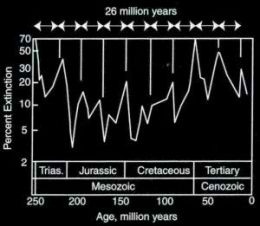
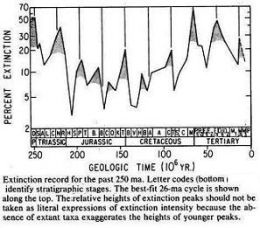
The periodic mass extinctions as discussed in March 1984 concerned a series of mass extinctions with interval between events of around 26_million years (refined later to 26.4_million years).
There were other serieses of mass extinctions apparently that had periodicity but of different period lengths, with at least one series having a periodic interval of some hundred million years or so, as determined by certain scientists later.
The original report for periodic mass extinctions gave 10 periodic extinction events or so, with an initial event that occurred around 248_million_B.C. (reference# wd1).
The well known dinosaurs extinction around 65_million_B.C. (on the so called K-T boundary, or the Cretaceous/Tertiary period) was the third periodic event before the end of the series as reported, and considered a major mass extinction event.
A mild mass extinction event 27_million years later occurred next around 38_million_B.C. (the Eocene/Oligocene period), and a weak last event again occurred 26.7_million years after around 11.3_million_B.C. (the mid-Miocene period).
Paleontologists David Raup and John Sepkoski of the University of Chicago reported the first known periodic mass extinctions in the summer of 1983, as based on fossil records analysis of 3,500 families of marine animals (reference# pc1).
Solar system items
Initial speculations for cause of periodic mass extinctions mostly focused on possible periodic disturbances on the Oort cloud (a source of comets) enveloping the solar system approximately 1 light year from the sun that result eventually to periodic impacts of comets and/or asteroids on Earth.
One of two favored initial hypotheses was a possible undetected dark star companion for the sun with an orbit that puts the so called 'death star' (also called 'Nemesis') into the Oort cloud every 26_million years.
Another was possible periodic encounters of the Oort cloud with massive interstellar clouds on the Solar System's gallactic plane crossings (called then as "gallactic oscillations"; the solar system follows a wavelike orbital path that puts it on one side or the other of the gallactic plane every 30_million years while it orbits the gallactic center every 220_million years).
More details regarding causes of periodic mass extinctions as initially hypothesized may be read in the April 19, 1984 issue of the science journal 'Nature'.
(Steps for assessing publications of 'Nature' online are provided at the end and titled "Science journal 'Nature' referencing".)
Incoming threats like asteroids and comets, because they are observable from along way off may be among the catastrophic mass killers that Man may easily counter or defend against.
Catastrophic mass killers coming up from underground though, may be more difficult to control. The well known 1908_A.D. explosion in Tunguska, Siberia was speculated as among these types of killers with underground causes (reference# wg1).
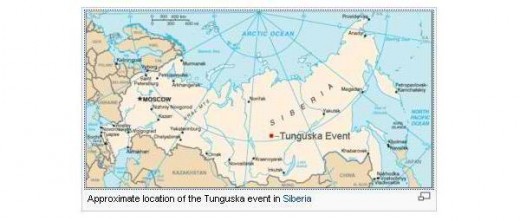
A planet exploding
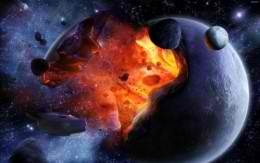
The Main Asteroid Belt
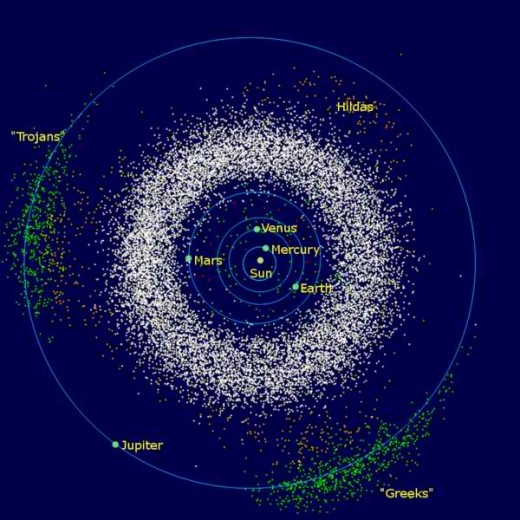
The Oort Cloud
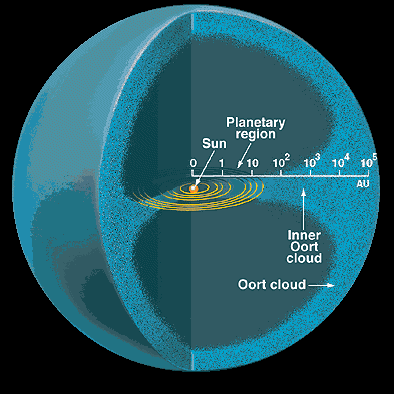
The Kuiper belt and Oort Cloud
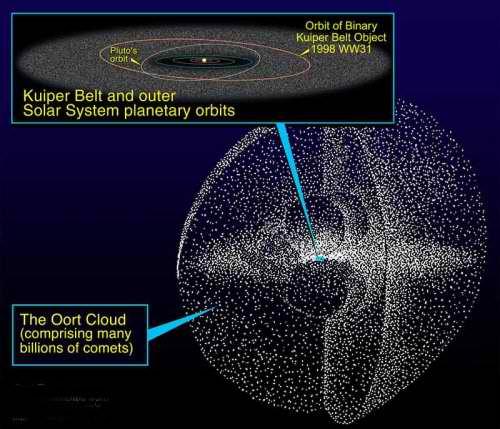
Planetary explosions (total or otherwise), a more serious explosion where Man may really be helpless, could also occur mainly with underground causes (more at the end under "Explosive planet Earth related hubs").
Water, so abundant on Earth, could make the planet candidate for planetary explosion (the hub "Dowsing for Water, Pre-exploding Planet Earth and Exploding Galaxies" describes a possible process).
Water was also plentiful apparently in the exploded planet hypothesized between the planets Mars and Jupiter. Its presence was considered factor in a total planetary explosion that resulted to the main asteroid belt and blew debris including comets to the Oort cloud (reference #s pe1, wg2, wh1). The hypothesis is more known as 'Exploded Planet Hypothesis' or EPH.
The 'Exploded Planet Hypothesis' may be the best explanation for many of the strange conditions that exist and are observable on many of the Solar System's planets, moons or other bodies.
What may provide though, as good if not better support for 'Exploded Planet Hypothesis' are the related mathematical calculations that may be counter checked by a good number of competent people.
The space between Mars and Jupiter is a large anomalous gap for astronomers since the 1800's because of non-conformity to an expected spacing of planets as predicted by a so-called Bode's law (published in 1772).
The main asteroid belt between Mars and Jupiter has total mass that is only a fraction of the mass for the planet that should exist in the space, as calculated by the Canadian astronomer Michael Ovenden of the University of British Columbia. The mass of the missing planet as calculated should be as big as that of the giant planet Saturn (reference# pe1).
The anomaly further may not exist indefinitely nor for long, as indicated by a law developed by Ovenden in 1972 (reference# pe1) showing that the configuration is unstable and that the major planets would reposition to more stable orbits if the solar system is subjected to forces like resistances to movements during passages through interstellar dust clouds (which do happen regularly; the resistances may also show up every 30_million years on the solar system's 'gallactic oscillation' crossings of the gallactic plane).
Comets expelled by the exploded planet may be known, as was done by tracing farther back in time the orbits, which may converge at a point between Mars and Jupiter around 4_million_B.C. Those that made first appearances were also calculated to complete their orbits in about 4_million years, an indication of the comets oscillating from point of origin, as well as
an indication of creation time (reference #s wg2, pe1)
The Kuiper Belt
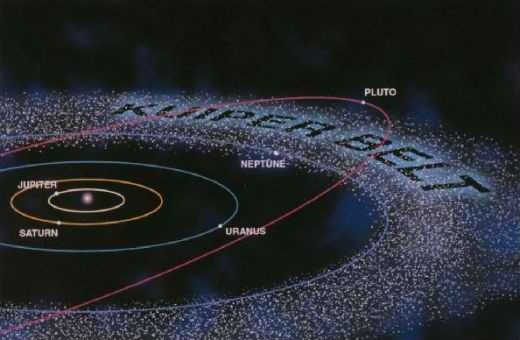
The main asteroid belt possibly at least could be a slim benefit for Earth's residents: it may function as some kind of partial shield or shock absorber against outer celestial bodies coming in through or near the asteroids' orbit (which also is on the same plane as most other orbiting bodies of the solar system).
Species on past geological eras could have had greater risk. Bigger and/or more mass killers may come from the farther 'Kuiper belt', a considerably wider belt with much more orbiting masses in the orbits of the far planets Neptune and Pluto. Mass killers could also come from anywhere else in the much bigger orbital space beyond the main asteroid belt.
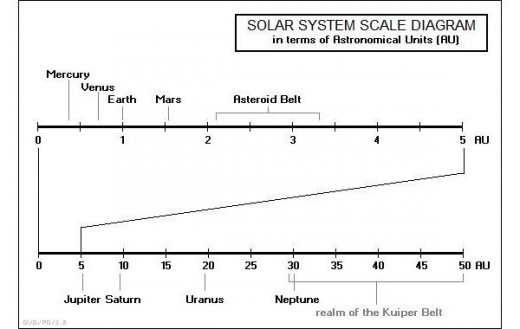
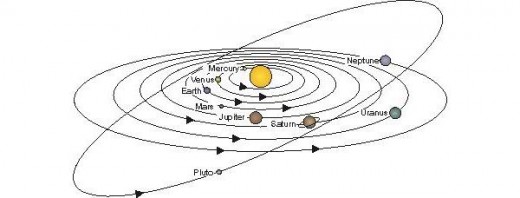
Most probably the current technological capability and resources of humanity may be good enough so that if utilized effective defense and/or survival measures may be set up against some types of killers that caused mass extinctions in Earth's past. (reference #s wb4, wb2, wb1, wb3).
Potential killers that can be monitored or can be seen with Man's current methodologies or hardwares, like asteroids and climate change may be among the said types of avoidable killers.
Man though may have very little knowledge about other massive disasters that possibly could happen on Earth, and likely for some time that he is bound to the planet, could be a very fat sitting duck specie so to speak as far as many mass killers are concerned.
Human society in its current state of being may not have much readiness for dealing with unknown hazards, except maybe under some familiar emergency situations like wartime conditions. That could change possibly with succeeding generations, maybe with the generation that follow the current one, or maybe the next, or the next, or... ad infinitum.
On the other hand, not all of planet Earth's resident species may really be helpless even as of now.
Those ancient stories about supernatural entities as well as maybe about the more recent UFOs could have some truth, and the concerned life forms may have their own methods of exit should earthly existence really get bad. Some of the superchaps, from extinct civilizations or unknown societies, might even be human.


Explosive planet Earth related hubs
(search key: terrestrial impact)
(wa1) site label: "Earth Impact Database" *****site address: http://www.unb.calpassc/ImpactDatabase/
(search key: nasa asteroid watch)
(wb1) site label: "Asteroid Watch - JPL NASA" *****site address: http://www.jpl.nasa.gov/asteroidwatch/
(wb2) site label: "Nasa Near Earth Object Program" *****site address: http://neo.jpl.nasa.gov
(search key: terrestrial impact)
(wb3) site label: "Asteroid Comet Impact Hazards" *****site address: http://impact.arc.nasa.gov/
(wb4) (news link at web reference www-b3) *****site address: http://impact.arc.nasa.gov/news_detail.cfm?id=181(opening title: "Planetary Defense Conference, April 2009")
(search key: oort cloud)
wb5).. "Oort Cloud" *****site address: http://www.wingmakers.co.nz/The Oort Cloud.html
(search key: mass extinction)
(wc1) site label: "Mass extinction - New World Encyclopedia" *****site address: http://www.newworldencyclopedia/entry/Mass_extinction (note: with extinction events graph 542 ma to present)
(search key: periodic mass extinction)
(wc2) site label: "Permian-Triassic extinction event - Wikipeddia, the free..." *****site_address: http://en.wikipedia.org/wiki/Permian–Triassic_extinction_event (note: Permian-Triassic extinction event is Earth's most severe extinction 251.4 million years ago; also called "the mother of all mass extinctions")
(search key: periodic mass extinction, Raup, Sepkoski)
(wd1) site label: "David M. Raup - Wikipedia - the free encyclopedia" .....site address: http://www.pnas.org/content/81/3/801.full.pdf .....opening title: "Periodicity of extinctions in the geologic past" (note: paper by David M. Raup and J.John Sepkoski, jr.; with extinction data for the past 250 ma)
(search key: periodic mass extinction)
(wd2) site label: "What ever happened to the theory of periodic mass extinctions..." .....site address: http://www.scientificamerican.com/article.cfm?id=what-ever-happened-to-the
(search key: periodic mass extinction)
(we3) site label: "Ebb and Flow of the Sea Drives World's Big Extinction Events" .....site address: http://newswise.com/articles/views/541743/
(we4) site label: "Ancient volcano may have caused mass extinction" .....site address: http://physorg.com/news/162738601.html
(we5) site label: "The Dark Star and Mass Extinctions" .....site address: http://www.darkstar1.co.uk/extinctions.html
(search key: mass extinction)
(wf1) site label: "The Sixth Extinction (Action Bioscience)" *****site_address: http://www.actionbioscience.org/newfrontiers/eldredge2.html
(search key: human activities 100,000 years)
(wf2) search result: "climate Timeline Tool: Climate History Overview"; *****site address= http://www.ncdc.noaa.gov/paleo/ctl/cliihis.html (with tabulation of human tools and environmental changes since around 100,000 years ago)
(wf3) search result: "climate Timeline Tool Overview"; *****site address= http://www.ncdc.noaa.gov/paleo/ctl/overview.html
(search key: planet explosion hypothesis)
(wg1) site label: "New Hypothesis of the Tunguska Explosion" *****site_address: http://www.spacedaily.com/news/deepimpact-02q.html
(search key: exploded planet)
(wg2) site label: "Exploding Planet Hypothesis" .....site address: http://www.enterprisemission.com/comets.html .....opening title: "A Key to the Myster y of Comet Origins in the Current Visit of Hale Bopp?"
(search key: Exploded Planet Hypothesis)
(wh1) site label: The Exploded Planet Hypothesis – 2000 *****site address: http://www.metaresearch.org/solar system/eph/eph2000.asp
(related subject hub)
(wh2) hub title: "Exploding A Planet" .....site address: http://hotshorturl.com/acd97
Printed references
pa1).. "Double Whammy" under "Astronomy"
(report in 'Discover' magazine for Apr.1992)
pa2).. "The Fire came By"
(article in 'Reader's Digest' magazine for Aug.1978 by John Baxter & Thomas Atkins)
pa3).. "The Flow of Heat From the Earth's Interior"
(article in 'Scientific American' magazine for Jan.1977 by David S. Chapman)
pb1).. "The Dinosaur Massacre - A Double Barreled Mystery"
(article in 'Science Digest' magazine for Sep.1983 by Robert Jastrow )
pb2).. "The Mass Extinctions of the Late Mezozoic"
(article in 'Scientific American' magazine for Jan.1982 by Dale A. Russell)
pc1).. "Evolution", under "1984 The Year in Science"
(report in 'Discover' magazine for Jan,1985 - noted the March 1984 gathering of
scientists from a broad range of fields to discuss a recent paper on events of mass
extinctions observed with 26 million year cycle occurrences; also reported the
discovery of a Homo erectus boy who lived around 1.6_million_B.C. in Kenya. ) about discovery of Homo Erectus boy circa about 1.6_million_B.C.)
pd1).. "Making A Chimp Out Of Man"
(article in 'Discover' magazine for Dec.1984 by Jared Diamond)
pd2).. "Hefty Ancestor" under "In The News"
(report in 'Discover' magazine for Dec.1984)
pe1).. "Exploding Planets"
(article in 'Science Digest' magazine for Apr.1982 by Thomas Van Flandern -
a Yale Ph.D. in astronomy / of the U.S. Naval Observatory)
pe2).. "Has the World Ended Before?"
(chapter8 of the book "Doomsday 1999 A.D." by Charles Berlitz)
pe3).. "Doomsday 1999 A.D." (1981 book by Charles Berlitz - informative facts given including the 'Bibliography', although the prediction missed)
pf1).. "Solving the Lost Continent Mystery"
(article in 'Reader's Digest' magazine for Oct.1978 by Thomas Fleming
summarizing Otto Heinrich Much's book titled "The Secret of Atlantis"
published in 1976)
pg1).. "A Step Farther Out" (book by Jerry Pournelle)
pg2).. "The Heritage Dictionary of the English Language"
(1973 dictionary; editor - William Morris)
Science journal 'Nature' referencing
Note: the sample steps given below results to writings related to the subject "periodic mass extinctions" as published on 19 April 1984.
1. Visit http://www.nature.com (a search box is at the site)
2. Enter "periodic mass extinction" at the search box
3. Select "advanced search" on the page that appears
4. Enter the publication date of "19 April 1984" on the available option box with the description "Published on specific date"
5. (a page follows showing 6 links, with 5 links that include for each a summary of possible cause for the periodic mass extinctions)







